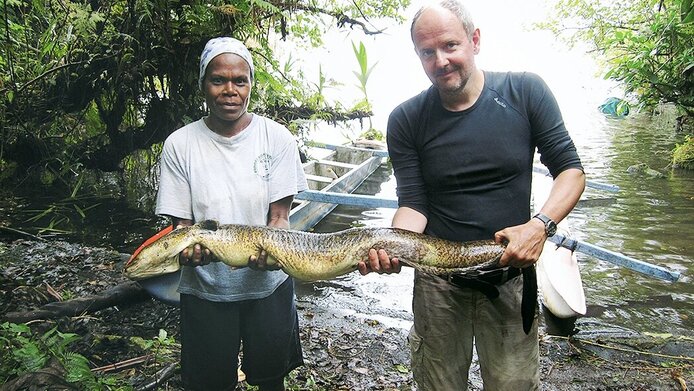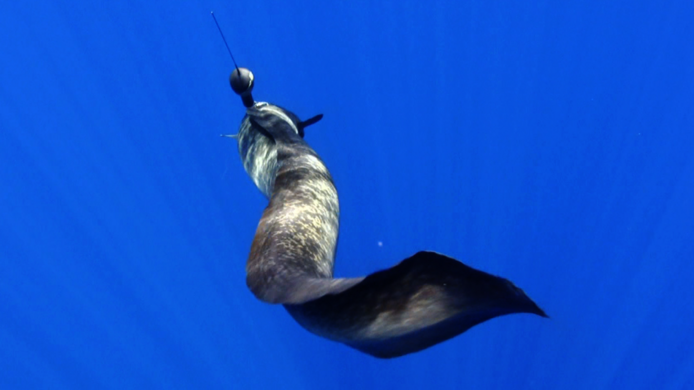Understanding the eel in order to save it

Have you ever eaten eel? If it was in Austria, it was most likely a European eel, which means that the animal was born in the Sargasso Sea near the American continent. The eel is a so-called “catadromous” migratory fish that migrates to the sea to spawn. The fish begins its several year- long journey across the Atlantic when it is still a larva, before swimming upstream into European rivers and lakes. Once it has fully matured, the eel migrates back downstream to the sea. The eel is not really indigenous to the Danube’s catchment area – until the 1980s a total of eleven million eels were fished from river deltas and placed in Austrian lakes, from where they were no longer able to migrate back to their spawning areas. The exact nature of the spawning process is not yet known. Up until now, eels have never been observed spawning in their natural environment. This lack of knowledge about life in the ocean is now becoming more and more a matter of survival for the eels: the European eel is today threatened with extinction, partly due to pressure from the fishing industry. In a project funded by the Austrian Science Fund FWF, which started in 2016, the biologist Robert Schabetsberger is now trying to shed light on the question of the eels’ spawning grounds.
Perfect conditions on a Pacific island
Schabetsberger was inspired to engage in eel research during a research project he funded privately after taking an interest in freshwater lakes on South Pacific islands. “These are the most isolated freshwater bodies in the world”, explains Schabetsberger. On the volcanic island of Gaua in the Vanuatu archipelago, the local guide caught two giant eels for their dinner. “I realised that this was the perfect place to study eel migration.” Some years later, Schabetsberger returned to the island to tag eels about to migrate to the sea with satellite transmitters. Since eels die after spawning, the locations where the transmitters emerge should provide an indication of where this takes place. The project was a success, three transmitters actually turned up in an area that had already been assumed to be a spawning ground. “In all likelihood, we were the first to track eels to their spawning sites. Thanks to these results we were able to ‘land’ the FWF project funding.”
Genetic and oceanographic investigations
In the ongoing biological basic research project, Schabetsberger is now working together with eel researchers from all over the world in order to explore different aspects of eel migration. In Vanuatu, the biologist even observed individual eels that looked like a hybrid of two species. Genetic studies undertaken by the Austrian zoologist Robert Jehle within the context of the project have meanwhile confirmed this. “We are currently examining about 500 genetic samples from the Pacific and Indian Oceans of three different eel species – a unique dataset”, notes the researcher. For years, international expeditions have been trying to track down the spawning areas of the 16 different species of eels with research vessels. The genetic investigations help to differentiate between the individual populations. One successful outcome of the project has been the analysis of data from automated sea buoys. “We looked at so-called Argo floats worldwide. 3,800 of these autonomous buoys have been deployed so far, and the number is constantly rising. These buoys record specific marine conditions, such as currents, temperature and salinity and then send the data to satellites.” The researcher reports that they made a surprising discovery when analysing the Argo float data in the vicinity of suspected spawning areas.
Salinity as a landmark?
“Almost all known and suspected spawning grounds are located on the western edges of areas of high salinity, so-called high salinity cores, at a depth of around 150 meters.” This could be an indication of the senses the eels use to navigate the seas on their journeys of several thousand kilometres. “The question of how they find their way remains unsolved and is the subject of a number of controversial theories”, says the biologist. In his opinion it is conceivable that salinity levels serve as a landmark. In a new tagging project on the island of Upolu in Samoa, the researchers managed to attach transmitters to four smaller eels, possibly males. However, the transmitters only remained attached to the eels for three weeks. The reason for this is unclear, but it is presumed that they were killed by predators. Nevertheless, it cannot be excluded that the spawning grounds are actually closer to the island than previously expected. At any rate, the smaller animals also showed the typical vertical migration movements. At daybreak the eels dive from about 150m to a depth of up to 750m and only rise again at nightfall.
Finding a way to breed eels
Exploring the eels’ spawning grounds could potentially secure the survival of this endangered species. “The idea is to get to know the conditions at the spawning sites. To date, it has not been possible to complete this cycle in the laboratory, which would enable the commercial breeding of eels in aquacultures. The European eel is threatened with extinction. Currently, juvenile eels are caught in large quantities when they start migrating upstream into rivers and then sold for several thousand Euros per kilo. They are then sent to eel farms in China, where they are raised and sold on to Japan. “Although the fishing of European eels is now officially banned, it is still happening” Schabetsberger notes critically. He now plans to extend his research to the Indian Ocean. “Meanwhile, the pressure on tropical species is also rising”, notes the researcher. Hence, time is of the essence.
Personal details Robert Schabetsberger is a biologist and lecturer at the University of Salzburg. His roots are in indigenous limnology and herpetology. In 1996, he started his work in marine biology with the help of an Erwin Schrödinger Fellowship from the FWF. The zoologist also works as a journalist, with more than 200 contributions to Austrian national television (ORF) to his name.
Publication






